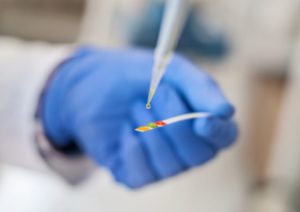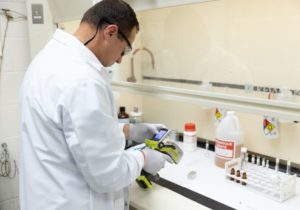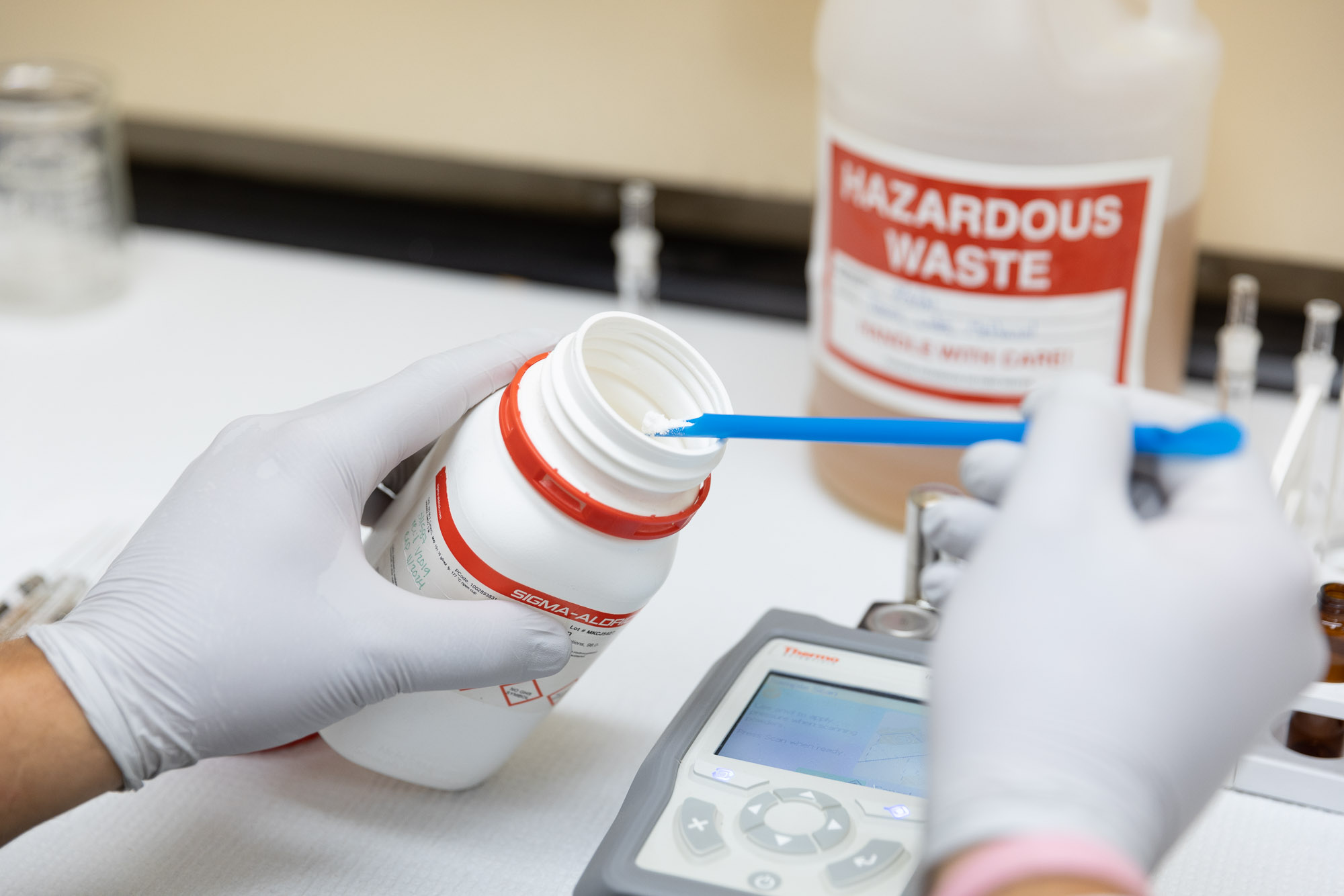Ensuring Safe Materials Acquisition, Storage, Maintenance, and Handling
Our CBRNE Tech Index team is focused on testing and evaluating a wide range of detection equipment and products – focused primarily on chemical, biological, and explosive threats, including threat agents and weapons – for use in the field or laboratory. Doing such specialized work means that we also must have expertise in working with the materials involved that we are testing for, ensuring the safety of our teams, colleagues, and communities. Further, this work helps ensure against chemical, biological, and explosive threats resulting from disasters and attacks.

Detection products for chemical, biological, and explosive threats can provide users with the identification of one or more specific chemicals or chemical classes, or the identification of a specific bacteria, virus, or biological material. This can include colorimetric tests, non-selective sensors that alert users to the presence of potential chemical threats, laboratory scale analytical systems, and a broad range of products in-between. We also assess chemical detection products designed to improve sample collection and accessories to analytical systems associated with chemical detection.
A sub-set of chemical detection, the team’s work on explosives detection can provide users with the identification of a specific explosive chemical(s) or explosive class.
Facilitating this work means that in addition to the detection equipment, we also work with the materials being detected. This requires the acquisition, storage, maintenance, and handling of these materials before, during, and after laboratory testing. A few of the materials we work with include:
- Chemicals – Fentanyl, cocaine, nerve agents, benzodiazepines, toxic industrial chemicals (TICs) and toxic industrial materials (TIMs), and vesicant agents
- Biologicals – Bacillus anthracis (anthrax), botulinum toxin, blood agents, and various other biological agents
- Explosives – primary explosives such as lead azide and TATP, secondary explosives such as C-4 and TNT, and tertiary explosives such as ANFO; also, low explosive propellants and pyrotechnic mixtures
Altogether, this work helps both private security and the U.S. Government in their screening and inspection of ports, border crossings, mass gatherings, and other high-priority locations susceptible to such chemical, biological, and explosive threats.
Acquisition of Materials
We acquire controlled substances through a few different means, as they can be shipped to us by a client or purchased from various approved vendors. We acquire chemical weapon agents (CWAs or chemical warfare agents) from the U.S. Army or follow regulations to synthesize them ourselves.
We maintain appropriate registrations with the Drug Enforcement Agency (DEA) to handle small, limited laboratory quantities of controlled substances. We are authorized to handle small quantities of Schedule I includes those drugs of high abuse potential with no accepted medical use, such as cannabis, heroin, LSD, MDMA, and methaqualone. Schedule II includes those drugs of high abuse potential with severe psychological or physical dependence, including fentanyl, oxycodone, morphine, methylphenidate, hydromorphone, amphetamine, methamphetamine (meth), pentobarbital, and secobarbital.
For explosives, we purchase or synthesize small quantities as needed for specific projects.
Storage of Materials
Controlled substances are stored at either ambient, 5° C, or -20° C, depending on the stability of the substance.
All CWAs, such as mustard, are stored at < 4° C, per U.S. Army guidance and best practices. Our SOPs then require us to “top off the vials,” replacing the air in the vials with an inert gas such as argon to help prevent degradation of the CWA.
We maintain the ATF and local fire marshal licensing required to store limited quantities of explosive materials. We have explosives storage capacity at our laboratories in Kansas City, Gaithersburg, and Charlottesville. We also maintain a small reference collection for use during testing and then procure any additional explosives needed for a project.
Maintenance of Materials
As CWAs are used, they are assessed for purity to ensure we know the quality of each agent used on programs. Sometimes impure materials are preferred, as they best mimic real-world scenarios. Other times, nothing but the purest materials are required. As CWAs degrade, we make the decision as to when they should be disposed of via decontamination of the CWA. The lifespan of the CWAs varies based on the chemical, how often a vial is used, and how it is used.
We perform both trace and bulk explosive chemical analysis. Trace is generally thought of as less than one can see with the eye and is often measured in parts per million or parts per billion. Many explosive chemicals are maintained in solution, which is beneficial for this type of trace level instrumental analysis. Other testing may require bulk explosive material. Bulk samples for testing purposes are considered to be amounts one can see with the naked eye. These “bulk” samples are generally small, with 50mg being typical. Some explosive materials such as C-4 and TNT can last many years without significant degradation in performance. Other explosives, such as ammonium nitrate-based emulsions do have a limited shelf life. We have subject matter experts who work with our customers to determine the appropriate types and amounts of explosive material needed to perform the required testing.

Handling of Materials
Each of the many materials we work with can be harmful if used improperly, so it’s critical that we handle them appropriately and using best practices. For instance, when handing controlled substances, NARCAN kits are available for check out and use if necessary.
For CWA, regardless of their source, we follow the safety, security, and accountability rules in our Provisioning Agreement. All CWA use aligns with proprietary best practices found in our Chemical Agent Hygiene Plan (CAHP), Dilute Solution Hygiene Plan (DSHP), Neat and Dilute solution General Operating Procedures, or Task specific SOPs and Test Plans. In brief, these plans list the requirements of necessary safety equipment/PPE. For instance, all work with handling open vials of CWAs is performed within a ventilation hood. We wear Tyvek suits, butyl gloves, safety glasses, and have escape respirators ready for neat CWA work. Dilute CWA work, below a defined threshold, can be performed using lab coats, safety glasses, and double nitrile gloves. These limits are defined in our Provisioning Agreement for Safeguarding Department of Defense Chemical Agents. Sometimes additional PPE is also required.
For explosives, we have chemists trained specifically to handle those materials. In general, the explosive samples handled in our laboratories are quantities that do not present an explosive hazard. Primary explosives, which do present a potential explosive hazard in small quantities, due to their sensitivity, are handled in very small quantities – a few milligrams. If the relative sensitivity of a suspected explosive is unknown, then a small sample is tested to determine if we are dealing with a primary explosive. Testing small amounts for sensitivity becomes particularly important when dealing with synthesized or improvised explosives.
Access to these chemicals and expertise in working with them enables CBRNE Tech Index to conduct independent, unbiased, and reliable research on chemical, biological, and explosive (CBRNE) detection, collection, protection, and analysis equipment. This information is then easily accessible and searchable for people all over the world at CBRNE Tech Index, making our knowledge available to help counter the WMD threat.

GETTING STARTED WITH MRIGLOBAL
Contact MRIGlobal to further understand how we power CBRNE Tech Index. Their expertise in testing and evaluating Chemical, Biological, and Explosives detection equipment and products for use in the field or laboratory is world-class and helps counter the WMD threat.
As a not-for-profit contract research organization, we have proven ourselves as an objective partner driven to make our clients’ products more successful. We specialize in defense, human health, pharmaceutical sciences, in-vitro diagnostics, energy, agriculture, and global health.
To learn more about the work we’ve done or how we can help you, contact us today. If you are part of an agency, business, or academic institution seeking assistance with a project, use our Project Quote Tool to get started.
SIGN UP FOR OUR NEWSLETTER
Sign up for the MRIGlobal newsletter! It’s the best way to get the latest updates in the world of applied scientific engineering research delivered directly to your inbox.

